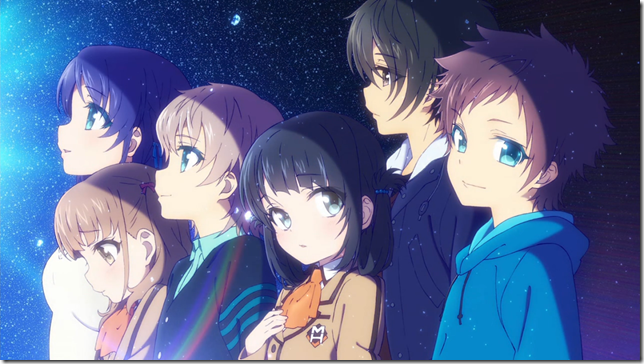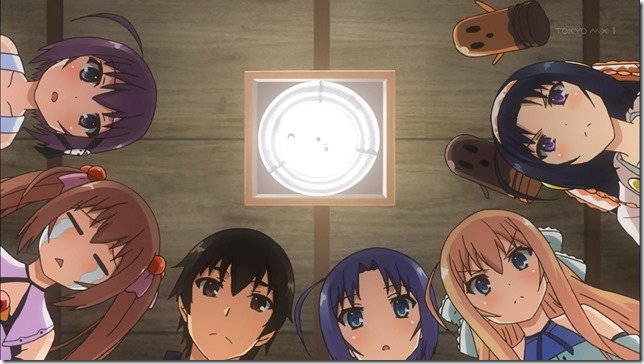A short rundown of 2014 anime shows containing commentary on religious/spiritual matters, for anyone interested in the topic matter and wondering what shows they should catch up on from the year gone by. The list is organized in alphabetical order of the English titles and only contains those 2014 series I had a chance to watch, so feel free to suggest other titles in the comments.
—
Amagi Brilliant Park
Religion: Shinto
Plot relevance: Medium
Problem matter: god-believer relationship, contemporary forms of worship
Notes: Religion started out with the idea that God created man. Then the skeptics said man created fictional gods as part of his imagination. Then there is hybrid concept, widely popular in contemporary Japanese fiction, that gods do exist… as long as they have enough believers. And the god’s influence is directly proportional to the number of believers.
Historically, the idea might stem from the country’s WW2 experience. The god-emperor had the entire nation put their lives on the line throughout the conflict, but his influence disappeared overnight when he was forced to broadcast a declaration he was in fact human.
In Amagi Brilliant Park, all the supernatural creatures are like kami of entertainment – they can only continue to exist in this world as long as people find them entertaining. Change the series-specific term animus to faith, and the parallels are pretty clear.
Interestingly, the people coming to the park are convinced everything they see is an empty charade… and perfectly satisfied with it, unaware of all the real miracles going down behind the scenes. This is reminiscent of Japan’s (and not only) contemporary approach to religion, which assumes near universal participation in religious rites and events with little actual belief or emotional attachment required.
Black Bullet
Religion: Christianity, Buddhism
Plot relevance: Medium
Problem matter: temptation, sin, forgiveness, purity, justice
Notes: Black Bullet often attempts to divide the right from wrong, good from evil, and in this search for a clear-cut division it presents a typically Christian approach (see my previous post on temptation in the series, or medieval’s posts on justice and other aspects of the series).
The weird thing is that the series wants to be at least superficially Buddhist in nature – the lotus flower, a Buddhist symbol of purity retained despite the filth of the surrounding world, is discussed openly within the series and shows up as the first kanji in the main character’s name (the ren in Rentarou).
Invaders of the Rokujyouma?!
Religion: Christianity, General
Plot relevance: Low/High (depending on character arc)
Problem matter: god-believer relationship, divine workings in everyday life, intercultural and interreligious understanding, essence of faith vs. its nomenclature
Notes: Rokujouma no Shinryakusha has the main character facing all kinds of supernatural events and characters and coming to terms with how they become a part of his everyday life. How much those events focus on religious matters depends on which character a given arc focuses on, with Sanae (ghost) and Yurika (magical girl) being standouts in this matter.
Sanae’s arc sees a transition from a “cheap” view of the divine, focused on talismans and other occult trinkets, to a genuine interpersonal relationship defined by mutual trust.
Yurika’s arc showcases how a benign and self-sacrificial power is constantly at work in our lives, protecting and aiding us from the shadows… only to be met with stubborn denial, disbelief and hypocrisy. The conclusion of the arc also calls from a separation of “good” from any one name or set of beliefs.
Love, Chunibyo & Other Delusions: Heart Throb
Religion: New Religions, General
Plot relevance: Medium
Problem matter: faith as a source of strength in everyday life, religion as a source of moral principles and guidance
Notes: The second season continues to present faith as a source of strength to change for the better, though the theme is not as central to the developments as it was in the first season.
Sanae’s search for religious guidance continues in this season, at one point leading her astray as she falls into the clutches of an impostor of her idol. (This is treated humorously, even though it parallels very difficult real-life problems.) Ultimately, the series seems to imply that relationships between people are more important than any concepts or ideals those people might seek. While I have nothing against Sanae and Shinka deepening their friendship, I was somewhat saddened to see Sanae’s spiritual search “diverted” and unresolved this way, considering how her religious/ideological zeal is such an important part of her character.
Nagi-Asu: A Lull in the Sea
Religion: Shinto, Pagan religions
Plot relevance: Medium-High
Problem matter: god-believer relationship
Notes: Nagi-Asu is notable for presenting the relationship between a god and his priest, particularly during strained and difficult moments when faith, love and personal convictions are all at odds with each other. Nagi-Asu avoids a dismissive or cruel portrayal of the divine, while choosing to present the main god of the story as a flawed but dynamic being with its own passions and goals to achieve.
No Game No Life
Religion: General (monotheistic)
Plot relevance: High
Problem matter: god as the source of moral order, god’s influence on the world, individual and societal self-improvement, proper worship
Notes: Possibly a criticism of real-life religions. The god in this series is physically present in the lives of mortals and doing his/her job by preventing anyone from using violence to achieve their means, while otherwise being content to give everyone their freedom as long as they play games and have fun.
It is telling that this benign One God took control of the world not because he/she was particularly powerful, but because all the other gods killed each other, leaving the only non-participant of the war the only divine being alive and at full power.
This god hands down ten commandments to all the creatures of his/her world, allowing them to resolve conflicts without resorting to violence. The ban of violence does not end up quite as revolutionary as viewers would assume, though. For the more powerful races, it is an annoyance limiting, but not eliminating all the ways in which they can dominate their lesser brethren. The commandments do not stop the rivalries between races and individuals – the race to take away the others’ resources in a struggle for survival – it merely changes its form.
It is curious, then, that Sora and Shiro, the two most irreverent characters in the show, end up being the gods greatest prophets. Only they see the god of games as an individual with a plan in mind, and are therefore able to see the true meaning behind the commandments and the world of peace they may one day allow to create. They are the closest one’s to fulfilling the god’s will, even as they openly issue a challenge to the deity. Their relationship with the god is personal, something shared between thinking beings and not weighed down with veils of uncomprehending worship, fear and empty gestures.
The fictitious religion of No Game No Life might be superficially different from real-life religions, but the lessons learned in the show still ring true in our world. The commandments of any religion are not restrictions we are to work our way around. They are supposed to be a path, and any path has its final destination. Turning a blind eye to this means not seeing the wood for the trees.
Riddle Story of Devil
Religion: Christianity, General
Plot relevance: High (but focused on closing episodes)
Problem matter: the faith vs. certainty dilemma, God’s will vs. free will, love and sacrifice, the relationship between the living and the departed
Notes: I must be somewhat jaded, for I did not really expect this series to discuss spiritual matters, the devil in the title notwithstanding. It was a pleasant surprise when the show chose to subvert my expectations.
The final episodes of the series show how an unrelenting attachment to free will and certainty ultimately require the characters to tear down the things they want to believe in. Is it better to hold onto love with faith as the only guarantee, or to destroy and know for sure, even if it leads to regret? The characters’ decisions are also a question directed at the viewers, who, often unknowingly, make the same decisions throughout their everyday life.
Saki: The Nationals
Religion: Shinto, Shamanism, Atheism, General
Plot relevance: Medium
Problem matter: interreligious communication
Notes: As always, Saki presents a battlefield of worldviews and beliefs clashing against each other. The theme of interreligious dialogue comes into focus particularly through Nodoka’s matches, when the vice-captain’s hardheaded atheistic ways collide with all sorts of miracles and magic. But the other characters offer some other tasty bits, like a demon-controlling miko bewildered at the idea of the existence of an exorcist clan.
With Buddhism/Shugendo playing an important part in Achiga-hen, and Christianity recently discussed in the manga, Saki seems intent on collecting as many of the world’s religions as possible.
Sword Art Online II
Religion: Christianity
Plot relevance: Medium (final arc)
Problem matter: family and region, the meaning of suffering
Notes: Kawahara offers a brief but tasteful description of how Christian teachings affected one girl’s life in the Mother’s Rosario arc of this popular franchise.
Yuuki Yuuna is a Hero
Religion: Shinto
Plot relevance: High
Problem matter: government and religion, family and religion, god-believer relationship
Notes: YuYuYu is particularly notable for its portrayal of a theocracy-based social order. The setting’s economy and survival are almost entirely dependent on the existence of the God-tree, and so the government and the country’s educational system are geared towards producing child-martyrs to fight against the God’’-tree’s enemies.
Showcasing both the power religion has to shape society as well as its perils, YuYuYu takes a complex approach to its portrayal of the God-tree cult. The religion might seem exceedingly cruel at times, like when we learn that the characters’ parents actually agreed to send their children to war, but there is also no doubt that it was the religious order that allowed Shikoku to survive the hundred years of total apocalypse.
At the end of the day, YuYuYu warns that the power of faith is great, but can be misused if the human factor is forgotten.




![[Vivid] Hanayamata - 11 [E9031827].mkv_snapshot_02.06_[2014.10.22_21.39.38] [Vivid] Hanayamata - 11 [E9031827].mkv_snapshot_02.06_[2014.10.22_21.39.38]](https://yaranakya.files.wordpress.com/2014/12/vivid-hanayamata-11-e9031827-mkv_snapshot_02-06_2014-10-22_21-39-38_thumb.jpg?w=644&h=364)










